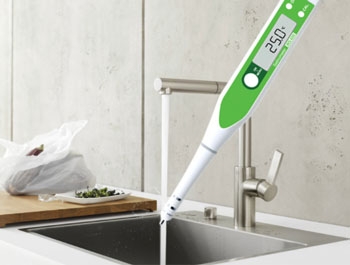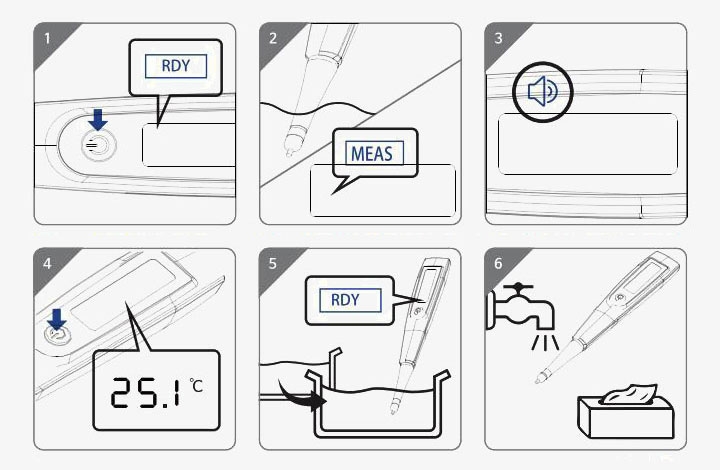A salinometer is an essential scientific instrument used to measure the salinity or salt concentration in a liquid, most commonly in seawater. Salinity is a critical parameter in oceanography, environmental monitoring, and various industrial processes, including desalination, aquaculture, and water quality management. Salinometers play a crucial role in understanding the physical and chemical properties of water and ensuring the proper functioning of various systems and processes. The sisco shop is here to give you more salinometer details.
Working Principle
The electrical conductivity of a solution increases with an increase in salt content, meaning that the higher the salt content, the lower the resistance, and the better the conductivity. When light passes from one medium to another, it undergoes refraction, and the ratio of the sine of the angle of incidence to the sine of the angle of refraction remains constant. This ratio is called the refractive index. By utilizing the property that the solubility content of soluble substances in a salt solution is directly proportional to the refractive index in a normal environment, the refractive index of the salt solution can be determined, allowing for the calculation of salt concentration.
Key Features and Components

- Sensors: Salinometers typically use various types of sensors to measure the electrical conductivity, refractive index, or density of the liquid being tested. These properties change with varying salt concentrations.
- Electrical Conductivity: In many salinometers, electrical conductivity sensors are commonly employed. As salt concentration increases, the liquid becomes a better conductor of electricity, allowing the instrument to calculate salinity based on the conductivity reading.
- Refractometry: Some salinometers utilize the principle of refractometry, where the refractive index of a liquid is measured. The refractive index of a liquid changes with salinity, and the instrument can calculate salinity from these changes.
- Density Measurement: Another method used is measuring the density of the liquid. As salt is added to water, its density increase, and salinometers can determine salinity from this parameter.
Advantages and Disadvantages
Advantages
- Accuracy: They provide precise measurements of salinity, which is crucial for understanding and managing water quality, oceanographic research, and industrial processes.
- Versatility: Salinometers are adaptable for use in various applications, including laboratory settings, environmental monitoring, and industrial facilities.
- Real-time Monitoring: Some salinometers are equipped for continuous and real-time monitoring, allowing for immediate detection of salinity changes.
Disadvantages
- Calibration: Regular calibration is necessary to maintain accuracy and ensure the instrument provides reliable measurements.
- Limited to Salinity: While salinometers excel at measuring salinity, they are not suitable for measuring other water parameters like pH, temperature, or dissolved oxygen.
Methods of Use
Preparation
- Ensure your salinometer is clean and in good working condition. Follow the manufacturer's instructions for maintenance and calibration.
- Prepare a sample of the liquid whose salinity you want to measure, making sure it's well-mixed if salinity varies within the sample.
- For seawater salinity measurements, ensure that the sample is free of debris or contaminants.
Measurement
- Electrical Conductivity Method: For salinometers based on electrical conductivity, immerse the instrument's conductivity sensor into the sample liquid.
- Wait for the instrument to stabilize or reach a reading. The time it takes to stabilize may vary depending on the instrument and the sample's characteristics.
- Record the salinity reading displayed on the salinometer's screen or indicated by the instrument's output.

Cleaning and Maintenance
After each use, clean the salinometer and sensor to prevent contamination and ensure accurate measurements in the future. Follow the manufacturer's maintenance instructions for your specific instrument. The choice of salinometer and method should depend on your application and the level of precision required for your salinity measurements.
Salinometers Find Application in Various Fields
- Oceanography: They are used to study and monitor the salinity of seawater as a fundamental parameter in understanding ocean circulation, thermohaline processes, and marine ecosystems.
- Environmental Monitoring: Salinometers are employed in environmental research and water quality monitoring, particularly in estuaries, lakes, and other bodies of water with varying salinity levels.
- Industrial Processes: In industries such as desalination, aquaculture, and wastewater treatment, salinometers are used to control and maintain the proper salt concentration for processes and systems.
- Laboratory Analysis: Salinometers are valuable tools for analytical chemistry in laboratories where precise salinity measurements are needed for various experiments and research.
- Navigation: In maritime applications, understanding the salinity of seawater can affect ship stability and buoyancy calculations.
- Food: Accurate salt measurements are crucial in food processing and production to ensure consistent taste, texture, and safety in food products.
In summary, salinometers are invaluable tools for quantifying the salt concentration in liquids, especially in seawater and industrial processes where salinity control is essential. They come in various types and designs, each suited to specific applications, and are a vital part of scientific research and practical applications that depend on precise salinity measurements.

